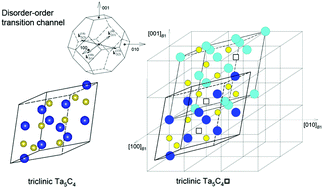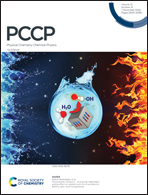Disorder–order and order–order phase transformations in Ta5C4 phases predicted using the evolutionary algorithm and symmetry analysis†
Abstract
A search for stable ordered phases in the nonstoichiometric cubic tantalum carbide TaC0.8 has been performed by use of the evolutionary algorithm and symmetry analysis. Four stable Ta5C4 superstructures with tetragonal, monoclinic, orthorhombic, and triclinic symmetry have been predicted for the first time. The DOS values of these Ta5C4 superstructures and stoichiometric TaC1.00 carbide have been calculated. All the tantalum carbide superstructures and stoichiometric TaC1.00 carbide have metal conductivity. The disorder–order phase transition channels TaCy → Ta5C4 associated with the formation of the considered model superstructures include superstructural vectors of non-Lifshitz stars {k1}, {k2}, and {k4}. The distribution functions of carbon atoms over the sites of the tetragonal, monoclinic, orthorhombic, and triclinic Ta5C4 superstructures have been calculated. For the first time, the physically permissible sequence of disorder–order and order–order phase transitions is established for the detected phases of the Ta5C4 family. Based on the formation enthalpy and the cohesion energy magnitudes, the triclinic Ta5C4 superstructure is the most favorable among all Ta5C4 phases predicted. The composition of the predicted Ta5C4 superstructures corresponds to TaC0.80 which possesses the highest melting temperature and hardness.



 Please wait while we load your content...
Please wait while we load your content...